- Home
- Jeff Mariotte
The Folded World Page 6
The Folded World Read online
Page 6
“You’re kidding.”
“It’s a sensitive issue. Especially combined with early childhood trauma, although there’s no indication that they even knew precisely what she had been through. Anyway, she didn’t appear to suffer any long-term effects from it, and it never made it into her Starfleet files, nor was it referenced in her psych evals. I put it together from press accounts and court records.”
“You said they’re sealed.”
“Any seal can be broken,” Chapel said with a smile. “You just have to have the right keys. I know this guy . . .”
“You don’t have to say any more,” Aimenthe said. “I get it.”
“He’s just a friend. Point is, Miranda Tikolo has suffered far more psychological damage than she even knows about. She thinks she’s okay with what happened to her off Outpost 4, and maybe she is. Then again—”
“Maybe she’s not.”
“Right.”
“You should try to get word to Doctor McCoy, if you can do it discreetly.”
“I will. In the meantime, I guess we just have to hope that she doesn’t suffer any more trauma. Poor thing’s had more than enough for one lifetime.”
• • •
“You know, Jim,” McCoy said quietly as he settled into his shuttle seat. “If we do find survivors over there—”
“We’ll have to figure out how to get them back to the Enterprise, on these shuttles,” Kirk finished for him. “I know, Bones. I don’t know what the answer is. I’m hoping that we’ll learn enough about the anomaly by going into it to come up with the solution.”
The problem had been nagging at him ever since they’d come up with the idea of pushing shuttles in from outside. Even that plan was questionable at best, since there was no way to know what would happen to the shuttles once they entered the fold.
As a test, they had removed the explosive combination of matter and antimatter from a photon torpedo and launched it into the fold, and it seemed to follow its ordinary trajectory with only a few minor wobbles. The ship’s instruments had lost track of it once it entered the fold, though, and the bridge crew had lost visual contact, regained it, then lost it again, for good. Spock had pointed out that without any passengers on board, there was no way to know what a sentient being would have experienced as the torpedo journeyed on what appeared to be a fairly straight course into the anomaly. Moving a physical object through space was one thing—moving through warped dimensions, possibly other realities, was something entirely different.
They were venturing into the unknown in a way that hadn’t been done since Zefram Cochrane took his first warp flight, on the fifth of April in 2063. That flight had brought Earth to the attention of the Vulcans and the larger community of the galaxy. Who knew where this one might lead?
Outside, the hangar deck had been depressurized, and the shuttles started to move. Kirk sat back, still impressed, even after all his experience, with the sensation of motion as the little craft launched into space. It was much more pronounced than he felt inside the Enterprise, even at warp speeds. And space looked very, very big from inside a tiny shuttle.
Within a short while, they were clear of the Enterprise and could glimpse it diminishing in size behind them. The second shuttle was a bright spot between them and the ship. The vessels locked in the center of the fold loomed larger and larger with every passing minute.
When it seemed that they had almost reached the twisting, shifting, color-phasing interior of the anomaly, Scotty’s voice sounded over the speakers. “It’s time to cut your power,” he said. “We’re ready to give you a push!”
Bunker, the crewman at the shuttle’s helm, turned back toward Kirk. “Sir?”
“Cut the engines,” Kirk ordered.
“Aye, sir.” He did. The steady drone of the shuttle’s engines vanished. Now Kirk felt doubly vulnerable, in a tiny craft under no power at all.
“Engines are off, Mister Scott,” Bunker declared. He had a rugged face, and silver threads shooting through his short, dark hair made him look older than he was. But he had the hands of a surgeon, and he knew how to fly a shuttle.
“Here comes a shove,” Scotty announced. “Ye might feel a wee jolt.”
“Hang on,” Kirk warned. He was glad he had. When the tractor beam reached them, the sensation was less a “wee jolt” and more like they’d been rear-ended by a craft twice their size.
“Everybody okay?” he asked when the shuttle had leveled off again.
A chorus of responses in the affirmative reached his ears.
“Mister Scott,” Kirk called.
“Aye, Captain?”
“When you push the second shuttle, you might want to try a lighter touch, Scotty. Or at the very least, make your warning a little stronger.”
“Sorry, Captain. I didnae mean t’ shake everybody up.”
“Understood. Everything seems fine now. Kirk out.”
And everything was fine. The tractor beam pushed the shuttle gently through the vacuum of space. Through the forward ports, he could see the kaleidoscope of colors loom larger, signifying that the dimensional fold was growing closer and closer.
“Steady, people,” Kirk said. “We’re about to go inside, and we haven’t the slightest idea what we’ll find there.”
“What do you think it’ll be like, Mister Spock?” someone behind him asked. Kirk thought it was Vandella, but he wasn’t certain.
“I am uncertain,” Spock replied, “but—”
Before he could finish his thought, the shuttle passed through the boundary of the fold.
Ten
“Captain!” Bunker called. “We’ve lost all our instruments!”
The comm system speakers crackled with static. Kirk could barely make out Scotty’s voice. “Captain . . . lost you on . . . status . . .”
“We’re fine, Scotty!” Kirk called. He had no idea if his signal would reach the Enterprise, but the ship’s communication systems were more sophisticated than the shuttle’s, so there was a chance. “We’re inside the anomaly, but we’re fine!”
“Captain,” Bunker said again. He sounded beyond anxious. “I’ve got no control.”
“We didn’t expect to, Mister Bunker. Steady as she goes.”
“I hope everybody’s strapped in,” Bunker said. “Because we’re—”
He couldn’t get the rest of his sentence out, but his meaning was obvious. The shuttle was rolling to starboard, fast. Outside, violet lightning carved a jagged streak across Kirk’s field of view, burning into his retinas. The light inside the shuttle was a strange shade of pink, flickering toward red near Kirk’s fellow passengers, as if they were throwing off energy that altered the light’s properties.
He gripped the console, as if that, rather than the straps, would hold him in. Halfway through the roll, the shuttle’s artificial gravity cut out. In a way it was a blessing, since it eliminated some of the nausea-making effects of the ship’s motion. It had its own drawbacks, though, as everything loose in the shuttle’s interior that had started to fall during the roll stopped and floated, bringing some of it back to where it could bump into the passengers. Kirk saw a tricorder heading toward him, and wondered who hadn’t secured it.
“It’s been a hell of a long time since I’ve been airsick,” McCoy said through clenched teeth. “But this trip just might do it.”
Kirk glanced over at Spock. Through his helmet, the Vulcan’s flesh looked pale, his lips were clamped shut, his eyebrows arched.
“. . . Kirk . . . read me?” Scotty’s voice demanded. Most of the transmission was lost to static.
“Scotty!” Kirk called. “We’re experiencing some . . . turbulence. But the shuttle’s intact and we’re okay.”
“. . . cap . . . jector . . .”
“Never mind that, Jim,” McCoy said. “He can’t hear you and we can’t hear him.”
The doctor was right. And Kirk had other things to worry about. The shuttle’s interior lights flickered twice, then blinked out. At the same
instant, the gentle background hum of its climate control system stilled. With it, the voices of the passengers went quiet.
“All systems are down, Captain,” Bunker said. “We’re dead in the water.”
Everybody had an environmental suit on, so their temperature and oxygen needs would be met for a while—if those systems continued to work. If not . . . then coming into the dimensional fold was the mistake that many had believed it would be.
“We are on our own,” Spock said. “We cannot reach Mister Scott, nor can we warn the second shuttle to turn around.”
“Full speed ahead,” Kirk said. Then he thought better of his response. “There must be a way to fix this.”
“ ‘Fixing’ it is beyond our capabilities,” Spock said. “The most we can do is hang on and hope.”
“Hope?” McCoy echoed. “That’s the best you’ve got?”
“It is the only option available to us at the moment, Doctor.”
“Being upset with each other isn’t going to help,” Kirk said. “And it’ll use up your oxygen faster.”
“I know, Jim,” McCoy said. “Sorry, Spock.”
“No apology is required.”
“Oh, for Pete’s sake, you—”
McCoy stopped in the middle of his sentence, because the shuttle shook as if it had just run into something solid. At the same instant, the interior lights returned, except—reversed was the only way Kirk could conceptualize it, like a negative image from an old photographic process. The light being emitted from the fixtures was black, the deepest shadows pure white. Every other surface was a shade of gray: light ones darker and dark ones lighter.
And the shuttle began a reverse of its earlier roll. Halfway through, the artificial gravity kicked in. Floating objects began to fall toward the overhead. Kirk recognized the tricorder, and realized it was in the exact same position he had seen it before. The odds against that happening were astronomical, unless—
The captain glanced at Bones and Spock. They were in precisely the same positions they had been before, their facial expressions identical. Even he was gripping the console in the exact same way.
This was not like the earlier roll, in the opposite direction—this was the earlier roll, in reverse. They were reliving the moment, backward, with the only difference being his awareness of it.
It couldn’t be happening.
But—unless a lack of oxygen was causing him to hallucinate—it was.
When the roll was finished, the lighting returned to normal, much to Kirk’s relief. Nearly everyone spoke at once, and Scotty’s voice blared from the speakers, still cut by static but not as completely obscured as before. “canna read you, shut . . . tain, are you . . .”
“We’re okay, Mister Scott,” Kirk replied, hoping that this time the chief engineer could hear him. “Repeat, we’re unharmed.”
“All systems are back on line,” Bunker reported.
“Roger that, Captain,” Scotty said. “I read ye loud and clear that time.”
“And you, Scotty,” Kirk said. “Loud and clear.”
Sweat beaded McCoy’s forehead. He probably wanted to mop it, but didn’t dare remove his helmet. “That’s a little better,” he said.
“It is indeed,” Kirk said. “Theories, Mister Spock?”
“It is possible,” Spock replied, “that the effects of the dimensional fold are more pronounced at its edges and that the interior of the fold is more stable. Having passed through what appeared to be a time reversal, we may have seen the worst of it.”
“I like the sound of that,” McCoy said.
“It is also possible,” Spock continued, “that what we are experiencing now is the exception and the other the rule. In which case, all precautionary measures should remain in effect.”
“Well, thanks for that,” McCoy observed.
“Point taken, Mister Spock,” Kirk said. “It appears that our environmental systems are back, but we can’t count on them staying that way. Keep your helmets on and be ready for anything.”
“Captain,” O’Meara said from behind Spock. “Can we contact the second shuttle? See how they’re faring?”
“Kirk to engineering,” Kirk said. “Scotty, any news on the other shuttle?”
“We lost ’em as soon as they entered the anomaly,” Scotty replied. “Same as we did you.”
“Give them a minute and then try again,” Kirk said. “How’s our heading?”
“You’re still on course.”
“Good.”
“In fact—”
“Yes?”
“Captain,” Bunker interrupted. “We’re there.”
Eleven
Miranda Tikolo had hoped she might doze off on the shuttle trip. Her sleep the night before had been restless, riven by bad dreams. But stepping onto the shuttle, all the memories of that time off Outpost 4 had come roaring back to her. Her heart rate quickened and she had a hard time drawing breath. She took a seat, grateful to get off suddenly unsteady legs.
“Are you okay?” someone asked. In their environmental suits, everybody looked the same, and Tikolo was having a hard time focusing. Her vision seemed to have narrowed down to a slender tube, with darkness encroaching on every side. The suit felt as if it was squeezing in on her, compressing her chest.
“Fine,” she said. “I’m fine. Yeah.”
“Because you look a little pale.”
“I said I’m fine,” Tikolo snapped. “Sorry.”
“Okay, okay.”
The petty officer strapped herself in. The pressure of the straps made the claustrophobic sensations even worse, but she swallowed her discomfort. There was no way out of it; she had volunteered for the mission, and when the captain had offered an opportunity to back out, she hadn’t taken it. She was in it for the duration.
Within a few minutes, everyone had boarded, and the shuttle was in motion, leaving the Enterprise behind.
• • •
The forward ports were filled with the accumulated starships gathered around the big one in the middle. “Big” didn’t actually begin to describe it. The closer they got, the more Kirk realized that it was gigantic, larger by far than any ship he had ever seen. From here, it didn’t appear all that impressive from a technological viewpoint—almost primitive, in fact, as if all the effort expended on it had gone into size instead of sophistication.
Some of the ships clustered around it were of recognizable origins. The McRaven was clearly visible, dead ahead. Kirk thought another was also a Starfleet ship, though of a class not manufactured for many years. Some of the ships were decaying, seemingly rusted through despite the lack of an atmosphere, and jammed so close together that they seemed to have melted into one another, making identification impossible. He thought he saw a Romulan bird-of-prey, an Andorian cruiser, something that might have been Tholian.
The big ship in the middle, though, was of no genesis Kirk could determine. “Mister Spock, can you determine the planet of origin of that huge ship?”
“No, Captain. I see no familiar markings or technology. In fact, there are no visible markings of any kind.”
That was strange in itself. Kirk couldn’t recall an example of a completely unmarked starship. This one had scorch stains down its long central section, and visible decay, so it was possible that the markings had simply been worn away by time and the difficulties of its journey. “Anybody have an idea?” he asked.
He heard only negative responses.
“Captain,” Scotty’s voice boomed over the speakers, almost as loud as if he had been in the shuttle with them. “The second shuttle’s reported in. They had a rough go of it for a while, but they’re on course and under power.”
“That’s good to hear,” Kirk said.
“They’re fifteen minutes behind you.”
“Understood,” Kirk said.
“I’m reversing the tractor beam that’s pushing you, to slow your momentum.”
Kirk felt the difference as soon as the engineer made the transitio
n; a stuttering hesitation in their forward motion, then an easy glide.
“That worked. We’re about to dock, Scotty,” he said. “We’ll keep you updated as we’re able. Kirk out.”
The McRaven loomed ahead of them, larger with every passing second. “Engines on, Mister Bunker.”
“Aye, Captain. Engines on.”
“Do we dare, Jim?” McCoy asked as the faint rumble of the engines came on. “We don’t know how—”
“You’re right, we don’t,” Kirk said. “But if we’re going to reach the McRaven’s hangar deck, we need thrusters.”
They were approaching the McRaven on its port side. As the most recent addition to the clustered mass, it was on the outside, some distance from the huge vessel in the center. To reach the hangar deck, they had to get to the rear of the ship, and hope the doors would open.
“Bring us in, Mister Bunker,” Kirk said.
Bunker was already concentrating on edging the shuttle into position. “Aye.”
The shuttle responded appropriately to Bunker’s efforts. Kirk dared to hope that Spock had been right, and the effects of the dimensional fold were concentrated at its edges. If they had already seen the worst of it, then it would be more than possible to send other shuttles in to carry survivors back to the Enterprise.
If there were survivors.
There were, he knew, a lot of ifs in that plan.
Still, there was a chance.
He would take it.
The shuttle moved easily around the McRaven. In a few minutes, they were approaching the hangar deck, in the engineering section.
The doors were closed.
“Hail the ship,” Kirk instructed.
“Shuttlecraft Galileo Two calling U.S.S. McRaven,” Bunker called. “Come in, McRaven.”
Only silence greeted them.
“Come in, McRaven. This is shuttlecraft Galileo Two, from the U.S.S. Enterprise.”

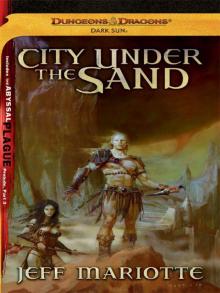 City Under the Sand
City Under the Sand The Burning Season
The Burning Season Sanctuary
Sanctuary Winds of the Wild Sea
Winds of the Wild Sea Serpents in the Garden
Serpents in the Garden Close to the Ground
Close to the Ground Blood Quantum
Blood Quantum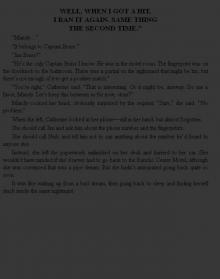 Brass in Pocket
Brass in Pocket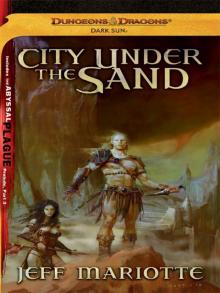 City Under the Sand: A Dark Sun Novel (Dungeons & Dragons: Dark Sun)
City Under the Sand: A Dark Sun Novel (Dungeons & Dragons: Dark Sun)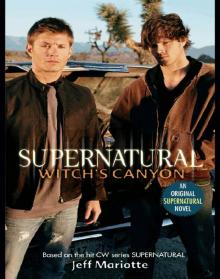 Witch's Canyon
Witch's Canyon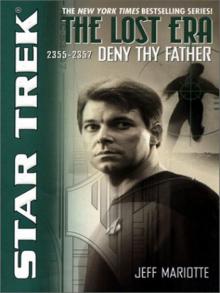 STAR TREK: The Lost Era - 2355-2357 - Deny Thy Father
STAR TREK: The Lost Era - 2355-2357 - Deny Thy Father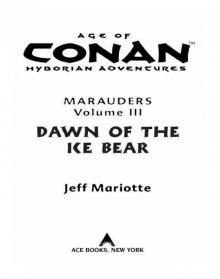 Dawn of the Ice Bear
Dawn of the Ice Bear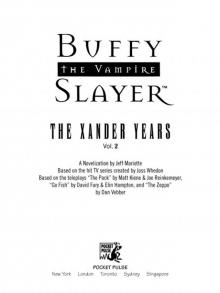 The Xander Years, Vol.2
The Xander Years, Vol.2 Ghost of the Wall
Ghost of the Wall 30 Days of Night: Light of Day
30 Days of Night: Light of Day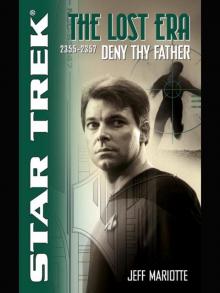 Deny Thy Father
Deny Thy Father Criminal Minds
Criminal Minds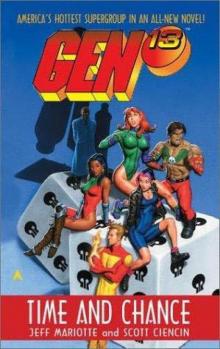 Time and Chance
Time and Chance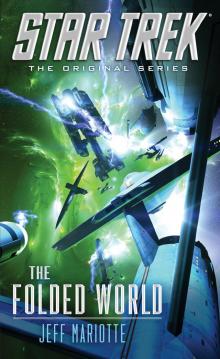 The Folded World
The Folded World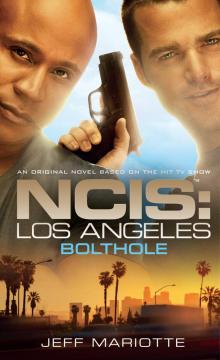 Bolthole
Bolthole Narcos
Narcos Right to Die
Right to Die